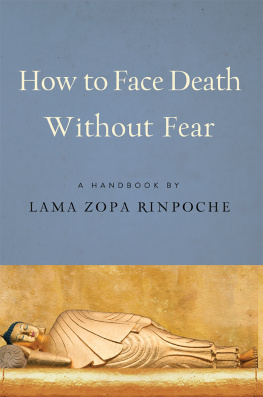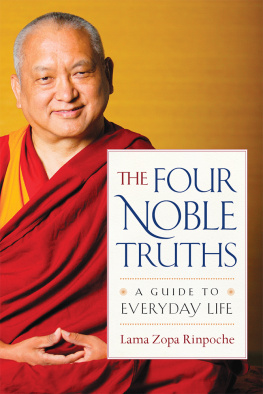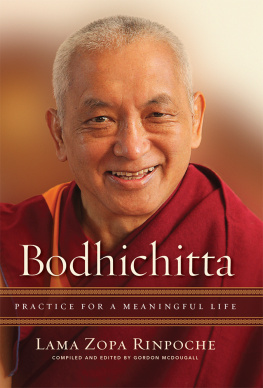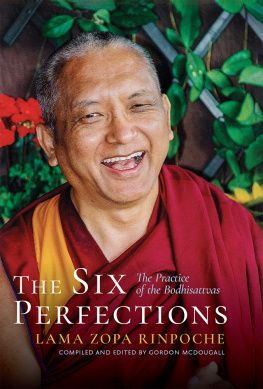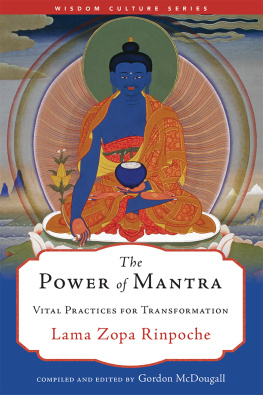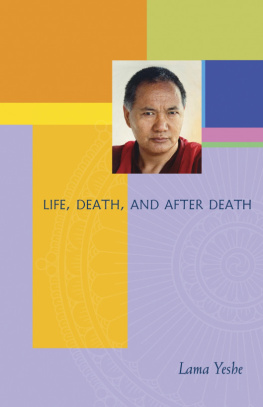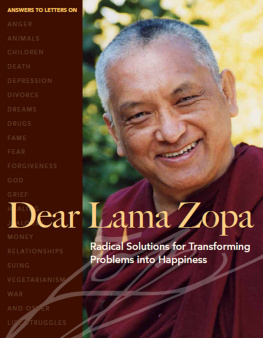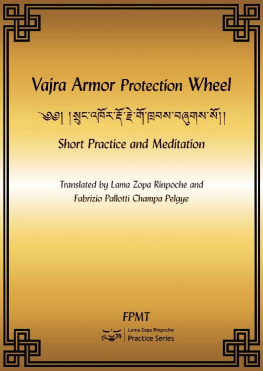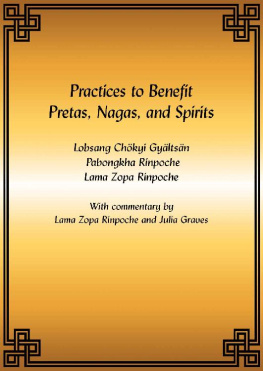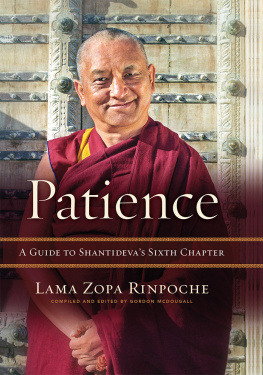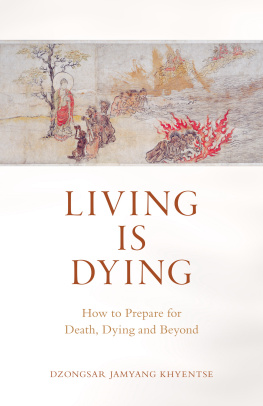LAMA ZOPA RINPOCHE is one of the most internationally renowned masters of Tibetan Buddhism, working and teaching ceaselessly on almost every continent.
He is the spiritual director and cofounder of the Foundation for the Preservation of the Mahayana Tradition (FPMT), an international network of Buddhist projects, including monasteries in six countries and meditation centers in over thirty; health and nutrition clinics, and clinics specializing in the treatment of leprosy and polio; as well as hospices, schools, publishing activities, and prison outreach projects worldwide. Lama Zopa Rinpoche is the author of numerous books, including Transforming Problems into Happiness, Ultimate Healing, The Door to Satisfaction, How to Be Happy, Wholesome Fear, Wisdom Energy, and Dear Lama Zopa from Wisdom Publications, as well as other works from the Lama Yeshe Wisdom Archive. To find out more about the FPMT, contact:
Tel. 503-808-1588 | Fax 503-808-1589
About the Editor
VENERABLE ROBINA COURTIN was ordained in the late 1970s and has worked full time since then for Lama Thubten Yeshe and Lama Zopa Rinpoches FPMT. Over the years she has served as editorial director of Wisdom Publications, editor of Mandala Magazine, executive director of Liberation Prison Project, and as a touring teacher of Buddhism. Her life, including her work with prisoners, has been featured in the documentary films Chasing Buddha and Key to Freedom.
Helping our loved ones at the time of death is the best service we can offer them, our greatest gift. Why? Because death is the most important time of life: its at death that the next rebirth is determined.
Lama Zopa Rinpoche
For years Lama Zopa Rinpoche envisioned a practical book to inform students of how to help loved ones have a beneficial death. How to Face Death without Fear has been compiled from years of Rinpoches teachings and has been lovingly edited by Venerable Robina Courtin.
Rinpoche provides detailed advice on how to help your loved ones prepare for the end of their life with courage, acceptance, and a mind free of fear. With great care, he explains what to do in the months, weeks, and days before death, how to handle the moment itself, what to do after the breath has stopped, and finally, what to do after the mind has left the body. Rinpoche provides the mantras, prayers, and meditations appropriate for each stage. This new edition of Rinpoches modern classic How to Enjoy Death makes it easy for the reader to find the right practice at the right time.
This handbook is an essential reference for Tibetan Buddhist caregivers, hospice workers, and chaplains. But, as Rinpoche points out, it is not only for people who work with the dying; it is education we all need.
Youll find solace in this wealth of advice, and youll also gain the confidence to ensure that your loved ones deathand your ownwill be joyful and meaningful.
The reality of death is an important opportunity for spiritual transformation. Kyabje Lama Zopa Rinpoches combined teachings and practices lead the reader to an understanding of this reality and help the person who is dying to achieve a better future life. Rinpoches clarity and blessings will be tremendously beneficial.
Yangsi Rinpoche, president, Maitripa College
Join Wisdoms mailing list and find out what to read next!
Receive the latest news and updates from Wisdom, including new releases and special offers.
Click here to sign up.

What Happens after Death?
Our Mind Continues after Death
W HAT HAPPENS AT DEATH and afterward is such an important subject, yet few people seem to want to know anything about it. We will definitely die, but unwilling to acknowledge that fact, we ignore it. It is as if we have all the symptoms of cancer but we never consult a doctor because we fear knowing the truth. Unless we face death with facts, we will just be terrified for no reason.
What does happen after death? We know what happens to the body. We can see that the breathing stops, the heart stops, the organs cease to function, and the body begins to decompose. Is that the end of us? If we did not have a mind that is separate from the body, that would be the end. But according to the Buddha, our mind, our consciousness, is not the body: it is nonmaterial energy. The simple fact is that the mind connects with a body for a certain period of time, and when the person dies, the mind continues. Because of karmaa persons past actions, which leave seeds in the mind that ripen as future experiencesthe mind goes to another body. This is what is called reincarnation.
Even though the body completely disappears until not even a single atom of what we once called my body can be found, our consciousness continues. Because of our deep craving for the physical, we enter an intermediate statea state between livesand then take another body, pushed into whatever rebirth in samsara our karma dictates. (See .)
Before giving his explanations about what to do at the time of death, Chden Rinpoche explained that samsara is the continuity of these aggregatesour body and mind joining to the next lifes aggregatescaused by karma and delusion. Another meaning, Rinpoche said, is cycling from birth to death to the intermediate state, and again birth, death, and intermediate state, continuously circling like this.
We ordinary beings have no control over where we are born. Highly realized beings such as arhats and higher bodhisattvas, however, have completely ceased even the seed of the fundamental ignorance that holds the self and everything else as existing from its own side, which is the root cause of repeated birth in samsara. (See .)
Reincarnation Is Not Just Some Asian Superstition
Western society does not have a culture that accepts reincarnation, so Westerners often presume it is an Asian superstition. Because it is not talked about, they think it cant be real. It is like the reluctance of Westerners to accept acupuncture when it was first introduced in the West. People found it impossible to believe that sticking a needle in one part of the body relieved the pain in another part, just because they had no knowledge of the wind energies that flow throughout the body. These days, acupuncture is more accepted, mainly because it has been shown to be effective. Similarly, people in the West are hearing more about reincarnation, and some are even starting to accept it, or at least not write it off as a primitive religious superstition.
There is a meditation where you observe that this present moment of mind is the direct result of the moment of mind that immediately preceded it, that the previous moment of mind is the direct result of the moment of mind before that, and so on. Because there can be no result without a cause, and because the main cause of a moment of mind must be its preceding moment, we can trace these moments of mind back to last week and last year and twenty years ago, right back to the moment of mind at birth, which must have been caused by the moment of mind at the last moment in the womb. Then we look even further, to the first moment of life at the time of conception. This first moment of mind in this life must have had a cause, and that cause must have been a previous moment of that mind, the mind of the last moment of the intermediate state. That can be traced back to the last moment of the previous life, and so forth.

